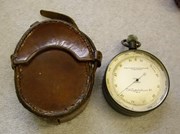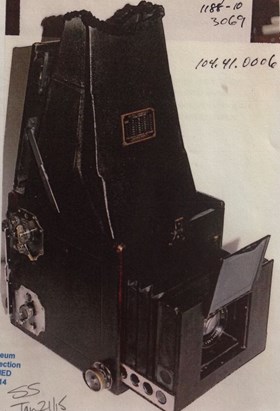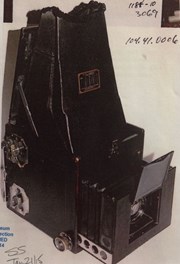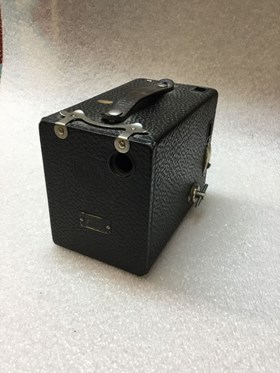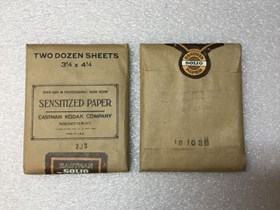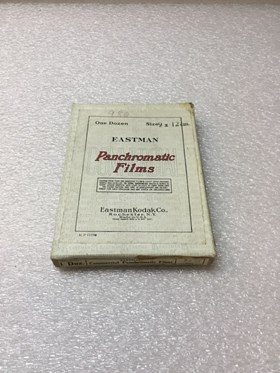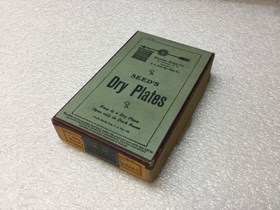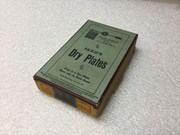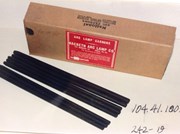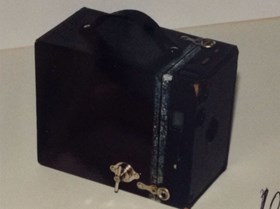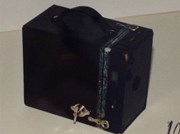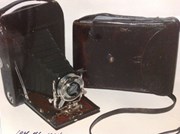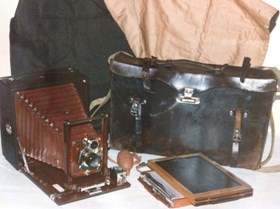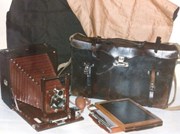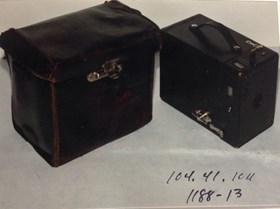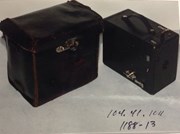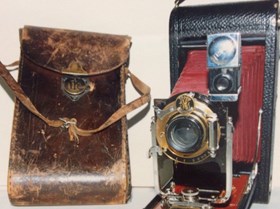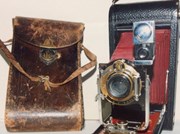Narrow Results By
- Date
- 1900 – 1925
- Material
- metal; fibre; paper; glass
- Catalogue Number
- 102.04.0386
- Description
- A plain, small, oval, sterling silver picture frame with rectangular photograph of blond woman. Two, small cutout feet of silver, form stand at bottom. Stiff, oval backing covered with faded purple velvet, as is rectangular support stand hinged to back. Photo inside is cut from contact sheet and is…
1 image
- Title
- Picture Frame
- Date
- 1900 – 1925
- Material
- metal; fibre; paper; glass
- Dimensions
- 6.6 x 1.1 x 4.4 cm
- Description
- A plain, small, oval, sterling silver picture frame with rectangular photograph of blond woman. Two, small cutout feet of silver, form stand at bottom. Stiff, oval backing covered with faded purple velvet, as is rectangular support stand hinged to back. Photo inside is cut from contact sheet and is photo of a picture of young, blond woman with hair piled atop head, and wearing scoop necked, ruffled blouse. Roughly cut oval of glass covers photo. Velvet covered ring fits closely inside silver frame to hold backing. “Sterling” stamped into back of right leg.
- Subject
- households
- decorative
- photography
- Credit
- Gift of Catharine Robb Whyte, O. C., Banff, 1979
- Catalogue Number
- 102.04.0386
Images
This material is presented as originally created; it may contain outdated cultural descriptions and
potentially offensive content.
Read more.
Aneroid Barometer
https://archives.whyte.org/en/permalink/artifact104.30.1006%20a%2cb
- Date
- 1900 – 1905
- Material
- metal; glass; paper; skin
- Catalogue Number
- 104.30.1006 a,b
- Description
- Two aneroid barometer-altimeters (a & b) labeled: “Keuffel & Esser Co. N.Y. MADE IN ENGLAND. Improved Surveying Aneroid Compensated” Black oxidized finish on the case. Altitude graduation up to 12,000 feet. Leather carrying cases contain comparative pressure test sheet dated 1903 and issued by Keuf…
1 image
- Title
- Aneroid Barometer
- Date
- 1900 – 1905
- Material
- metal; glass; paper; skin
- Dimensions
- 10.5 x 8.5 cm
- Description
- Two aneroid barometer-altimeters (a & b) labeled: “Keuffel & Esser Co. N.Y. MADE IN ENGLAND. Improved Surveying Aneroid Compensated” Black oxidized finish on the case. Altitude graduation up to 12,000 feet. Leather carrying cases contain comparative pressure test sheet dated 1903 and issued by Keuffel & Esser.
- Subject
- photography
- Vaux family
- surveying
- science
- Credit
- Gift of Molly Vaux, New York, USA, 1999
- Catalogue Number
- 104.30.1006 a,b
Images
This material is presented as originally created; it may contain outdated cultural descriptions and
potentially offensive content.
Read more.
- Date
- 1900 – 1940
- Material
- leather; metal; glass
- Catalogue Number
- 104.41.0006
- Description
- Auto Graflex, curtain aperture, leather covered box, leather handle centre top. Hinged top opens a folded curtain aperture. Soft, tufted fabric around eye edge. 4.0x6.0 plate on plate on side of curtain has aperture chart. Texture knob on side of camera rolls out: "Carl Zeiss Jena No.46774" lens. L…
1 image
- Title
- Camera
- Date
- 1900 – 1940
- Material
- leather; metal; glass
- Dimensions
- 24.0 x 21.3 x 23.3 cm
- Description
- Auto Graflex, curtain aperture, leather covered box, leather handle centre top. Hinged top opens a folded curtain aperture. Soft, tufted fabric around eye edge. 4.0x6.0 plate on plate on side of curtain has aperture chart. Texture knob on side of camera rolls out: "Carl Zeiss Jena No.46774" lens. Lens is enclosed and sits back of front, a metal hinged cover opens to expose lens when rolled out. Removable film pack on back.
- Subject
- households
- hobbies
- photography
- Credit
- Gift of Catharine Robb Whyte, O. C., Banff, 1979
- Catalogue Number
- 104.41.0006
Images
This material is presented as originally created; it may contain outdated cultural descriptions and
potentially offensive content.
Read more.
Brownie Camera
https://archives.whyte.org/en/permalink/artifact104.41.0176
- Date
- 1901 – 1935
- Material
- leather; metal; cardboard; glass
- Catalogue Number
- 104.41.0176
- Description
- Dark brown/black Kodak No. 2 Brownie camera with a leather strap that has “BROWNIE’ stamped on it on the top, two viewfinders [one on top, one on the right side], a back panel that hinges open to access the film compartment [this compartment is metal and removable], a thin metal rod that rotates th…
1 image
- Title
- Brownie Camera
- Date
- 1901 – 1935
- Material
- leather; metal; cardboard; glass
- Dimensions
- 11.3 x 9.4 x 14.4 cm
- Description
- Dark brown/black Kodak No. 2 Brownie camera with a leather strap that has “BROWNIE’ stamped on it on the top, two viewfinders [one on top, one on the right side], a back panel that hinges open to access the film compartment [this compartment is metal and removable], a thin metal rod that rotates the film inside, and the lever that triggers the lens. Attached to the back is a small rectangular metal plaque with the manufacturer’s details and above it is an embossed stamp that identifies this camera as being “No. 120.”
- Credit
- Gift of Eddie Hunter, Banff, 1995
- Catalogue Number
- 104.41.0176
Images
This material is presented as originally created; it may contain outdated cultural descriptions and
potentially offensive content.
Read more.
- Date
- 1905 – 1924
- Material
- paper;
- Catalogue Number
- 104.41.0200 a,b
- Description
- Two packages of 3 1/4 x 4 1/4 Kodak Sensitized Paper, also known as Solio Paper, in brown paper wrapping - unopened. Details of the contents stamped on the front in black ink, and the packages are held closed with a brown, orange, and white “EASTMAN SOLIO PAPER” sticker that wraps over the bottom e…
1 image
- Title
- Photo Paper
- Date
- 1905 – 1924
- Material
- paper;
- Dimensions
- 0.9 x 9.4 x 11.8 cm
- Description
- Two packages of 3 1/4 x 4 1/4 Kodak Sensitized Paper, also known as Solio Paper, in brown paper wrapping - unopened. Details of the contents stamped on the front in black ink, and the packages are held closed with a brown, orange, and white “EASTMAN SOLIO PAPER” sticker that wraps over the bottom edge from front to back. Faded stamps on the backs are mostly illegible, but the expiration date of “MAY 15 1924” is visible.
- Credit
- Gift of Robert Crosby Family, Banff, 1998
- Catalogue Number
- 104.41.0200 a,b
Images
This material is presented as originally created; it may contain outdated cultural descriptions and
potentially offensive content.
Read more.
Panchromatic Film
https://archives.whyte.org/en/permalink/artifact104.41.0201
- Date
- 1906 – 1923
- Material
- cardboard; paper;
- Catalogue Number
- 104.41.0201
- Description
- One box of a dozen 9x12cm Eastman Commercial Panchromatic Films - unopened. The box has a large paper label on the lid containing the manufacturer and development details throughout, as well as “9.80” written in pencil at the top. The edges and bottom of the box are sealed with brown paper adhesive…
1 image
- Title
- Panchromatic Film
- Date
- 1906 – 1923
- Material
- cardboard; paper;
- Dimensions
- 1.5 x 10.0 x 13.7 cm
- Description
- One box of a dozen 9x12cm Eastman Commercial Panchromatic Films - unopened. The box has a large paper label on the lid containing the manufacturer and development details throughout, as well as “9.80” written in pencil at the top. The edges and bottom of the box are sealed with brown paper adhesive tape, the right-hand side is stamped with “DEVELOP BEFORE APRIL 1923.”Panchromatic film is a kind of black-and-white emulsion that is sensitive to all visible light wavelengths and creates realistic photographs - it could also be used successfully for colour and black-and-white motion pictures as early as 1913. One downside to panchromatic film was that it had to be developed in complete darkness as it was sensitive to the red lights standard in many darkrooms.
- Credit
- Gift of Robert Crosby Family, Banff, 1998
- Catalogue Number
- 104.41.0201
Images
This material is presented as originally created; it may contain outdated cultural descriptions and
potentially offensive content.
Read more.
- Date
- 1908 – 1908
- Material
- cardboard;
- Catalogue Number
- 104.41.0202
- Description
- Empty cardboard box of Kokak Solio Toning and Fixing Powder cartridges with manufacturer and product details printed throughout the white box in red and black. Toning powders were chemical compounds designed to react with the emulsion layers of positive photographs that altered the tone (or colour)…
1 image
- Title
- Solio Powder
- Date
- 1908 – 1908
- Material
- cardboard;
- Dimensions
- 2.2 x 10.2 x 8.8 cm
- Description
- Empty cardboard box of Kokak Solio Toning and Fixing Powder cartridges with manufacturer and product details printed throughout the white box in red and black. Toning powders were chemical compounds designed to react with the emulsion layers of positive photographs that altered the tone (or colour) of the image, usually turning a standard black-and-white image into warmer shades of red, brown, and/or purple - sepia is a very common tone. Additionally, toning powders could be combined with a fixing agent that stabilized the emulsion layer to prevent it breaking down or fading, flaking off, or otherwise ruining the image as it set.
- Subject
- Crosby family
- Abegweit
- photography
- photographic equipment
- chemicals
- photograph development
- Kodak;
- Credit
- Gift of Robert Crosby Family, Banff, 1998
- Catalogue Number
- 104.41.0202
Images
This material is presented as originally created; it may contain outdated cultural descriptions and
potentially offensive content.
Read more.
Exposure Plates
https://archives.whyte.org/en/permalink/artifact104.41.0207
- Date
- 1902 – 1920
- Material
- cardboard; paper; glass;
- Catalogue Number
- 104.41.0207
- Description
- Box of one dozen 3 1/4 x 5 1/2 glass Seed’s Dry Plates with cut paper adhesive tape around the edges and bottom and manufacturer details printed on a pale green background throughout the lid. These dry plates were invented by M.A. Seed in 1879 and became very popular with photographers as the plate…
1 image
- Title
- Exposure Plates
- Date
- 1902 – 1920
- Material
- cardboard; paper; glass;
- Dimensions
- 3.0 x 9.3 x 15.0 cm
- Description
- Box of one dozen 3 1/4 x 5 1/2 glass Seed’s Dry Plates with cut paper adhesive tape around the edges and bottom and manufacturer details printed on a pale green background throughout the lid. These dry plates were invented by M.A. Seed in 1879 and became very popular with photographers as the plates came pre-prepared with the emulsion layer already applied - prior to “dry” plates, photographers would need portable dark rooms in which they would create their liquid emulsions prior to taking a photograph [known as “wet” plates]. Seed’s dry plates still required they be opened in a dark room, but this could be accomplished in the field by placing a dark sheet over the camera while loading and unloading the plates. In 1902, Eastman Kodak purchased Seed’s company [Seed Dry Plate Co.], but continued to capitalize on his name due to its reputation among consumers.
- Credit
- Gift of Robert Crosby Family, Banff, 1998
- Catalogue Number
- 104.41.0207
Images
This material is presented as originally created; it may contain outdated cultural descriptions and
potentially offensive content.
Read more.
Folding Camera
https://archives.whyte.org/en/permalink/artifact104.41.0245
- Date
- 1905 – 1927
- Material
- metal; leather; glass; wood
- Catalogue Number
- 104.41.0245
- Description
- A large, black leather bound square folding camera from Eastman Kodak Co. The camera when folded looks like a leather case with a leather handle attached at the top with two large metal buttons. One of the shorter sides features varying mechanisms to make adjustments to the camera. At the top is re…
1 image
- Title
- Folding Camera
- Date
- 1905 – 1927
- Material
- metal; leather; glass; wood
- Dimensions
- 24.6 x 23.0 x 10.0 cm
- Description
- A large, black leather bound square folding camera from Eastman Kodak Co. The camera when folded looks like a leather case with a leather handle attached at the top with two large metal buttons. One of the shorter sides features varying mechanisms to make adjustments to the camera. At the top is rectangular shaped metal plate with a knob that can be twisted and will make a clicking noise with a engraved arrowed to indicate turn the knob counter-clockwise, underneath is a l-shaped leaver that has a minor turn radius with an “M” engraved on the one arm. In the middle is a gold metal knob that can be pushed away from the case to open the one side and reveal the camera. Near the knob is a metal plate that reads “SPEED GRAPHIC CURTAIN APERTURE”, a graph with numbers, and “FOLMER & SCHWING DIVISION” “EASTMAN KODAK CO.” “13476 ROCHESTER, N.Y.” At the bottom is another square-shaped plate with a knob that can be turned that corresponds to numbers in a small black circle in the plate. On the top of the case is a white sticker with blue numbers “68622”. On the back of the case is a section for film holders/double dark slides and a glass plate behind a piece of the case that opens with a clasp at the bottom of the square. The other short side features small metal circles and a hole for a screw - most likely for a tripod mount. The front of the case is flat. When the case is opened it reveals the folded camera with black bellows and a silver metal face with a Wollensak Betax No.3 lens. It moves on a track to extend and retract with a mechanism in the front that when pinch together allows for the movement of the camera. There is a partially ripped sticker on the wood panel that reads “Sales - Service - Repairs” “Camera & Instrument Crafts” “9452 Calgary, Alta.” One side of the panel also features a black plate with numbers for focal range.
- Credit
- Gift of Don Harmon, Banff, 1985
- Catalogue Number
- 104.41.0245
Images
This material is presented as originally created; it may contain outdated cultural descriptions and
potentially offensive content.
Read more.
- Date
- 1905 – 1927
- Material
- wood; metal; fabric
- Catalogue Number
- 104.41.0248 a-d
- Description
- A wooden tripod made by Eastman Kodak company. 3 sets of wooden legs that fold and slide out to extend - brass detailing and screw-knobs. The top of the tripod is a circular disk with brass detailing on the bottom to attach the legs, and the top of the disk has brown felt for where the camera would…
1 image
- Title
- Camera Tripod
- Date
- 1905 – 1927
- Material
- wood; metal; fabric
- Dimensions
- 112.0 x 18.0 cm
- Description
- A wooden tripod made by Eastman Kodak company. 3 sets of wooden legs that fold and slide out to extend - brass detailing and screw-knobs. The top of the tripod is a circular disk with brass detailing on the bottom to attach the legs, and the top of the disk has brown felt for where the camera would sit. Dimension for d) 3.3 x 15.4 x 15.4 cm
- Credit
- Gift of Don Harmon, Banff, 1985
- Catalogue Number
- 104.41.0248 a-d
Images
This material is presented as originally created; it may contain outdated cultural descriptions and
potentially offensive content.
Read more.
- Date
- c. 1910
- Material
- leather; metal; glass; wood; plastic; textile
- Catalogue Number
- 104.41.0249
- Description
- Buster Brown box camera with brown leather handle. Solid structure with black textile covering made to resemble leather. The front of the camera has a hole that likely once held a lens. There are two smaller holes in the upper corner of the front, which contain small glass parts. There is also meta…
1 image
- Title
- Box Camera
- Date
- c. 1910
- Material
- leather; metal; glass; wood; plastic; textile
- Dimensions
- 13.5 x 9.7 x 15.9 cm
- Description
- Buster Brown box camera with brown leather handle. Solid structure with black textile covering made to resemble leather. The front of the camera has a hole that likely once held a lens. There are two smaller holes in the upper corner of the front, which contain small glass parts. There is also metal hardware holding the front exterior panel to the structure. One side has a round hole with glass held by metal hardware, creating a viewfinder. There is also a metal winding mechanism, and a lever for the shutter release. The lever activates a mechanism that quickly uncovers and then re-covers the inner lens. The rear part of the camera has a small round, red-tinted window that would have shown the number for the section of film in position. At the top is a metal hinge that can be lifted to open the back panel, which comes down and is connected with a textile hinge. The top of the camera has a leather handle attached with metal pegs. The leather handle is worn, but you can see that it has been engraved by the manufacturer with the text: “No. 2A BUSTER BROWN”. There is also a viewfinder on the front corner. When the metal latch is opened, the rear panel opens and the interior cartridge can be seen. Pulling out the handle of the winding mechanism on the side of the camera releases the cartridge so that it can be removed. It’s a wooden box with a lens on the front and it has compartments for spools that hold the film. There is a spool in one side, but the other is empty. There are also two metal rollers that would hold the film in place. One side of the wooden cartridge is engraved with the following text: “MFD. BY”; “ANSCO COMPANY”; “BINGHAMTON, N.Y.”; “U.S.A.”; “PATENTED”; “JUNE 23 1903”; “SEPT. 20 1910”; “OTHER PAT. PENDING”; “FOR 6A OR 6B FILM”. Above the engraving is some handwriting in pencil that reads “6-A”; “2 1/2 x 4 1/2”. link to pdf of user manual: http://www.cameramanuals.org/agfa_ansco/ansco_buster_brown_camera.pdf
- Credit
- Gift of Don Harmon, Banff, 1985
- Catalogue Number
- 104.41.0249
Images
This material is presented as originally created; it may contain outdated cultural descriptions and
potentially offensive content.
Read more.
Folding Camera
https://archives.whyte.org/en/permalink/artifact104.41.0280
- Date
- c. 1910
- Material
- wood; metal; leather
- Catalogue Number
- 104.41.0280
- Description
- A small black box folding camera. On the top of the camera is a set of two hinged latches which open the back panel of the camera (the leather is separating from the camera). There is also a bump on the top of the camera that when pressed releases the front panel of the camera that reveals the fold…
1 image
- Title
- Folding Camera
- Date
- c. 1910
- Material
- wood; metal; leather
- Dimensions
- 11.5 x 8.0 cm
- Description
- A small black box folding camera. On the top of the camera is a set of two hinged latches which open the back panel of the camera (the leather is separating from the camera). There is also a bump on the top of the camera that when pressed releases the front panel of the camera that reveals the folding lens, tracks, and a viewfinder near the top of the panel. There is no lens, and the silver metal lens holder is separated from the red bellows. On the other side of the front panel is a hole which a tripod can be screwed into. There are also two small holes on either side of the camera near the top, possibly for a strap.
- Credit
- Gift of Catharine Robb Whyte, O. C., Banff, 1979
- Catalogue Number
- 104.41.0280
Images
This material is presented as originally created; it may contain outdated cultural descriptions and
potentially offensive content.
Read more.
Folding Camera
https://archives.whyte.org/en/permalink/artifact104.41.0281
- Date
- 1906 – 1916
- Material
- wood; metal; leather
- Catalogue Number
- 104.41.0281
- Description
- A medium-sized black box folding camera. The top of the camera features a leather handle stamped with “PREMO” in the middle attached with two silver clasps, a circular black and red sticker with white text that reads “FILM” “THE” “PREMO” “CAMERA” “NO.1”, a set of two silver metal latches that open …
1 image
- Title
- Folding Camera
- Date
- 1906 – 1916
- Material
- wood; metal; leather
- Dimensions
- 16.0 x 12.1 cm
- Description
- A medium-sized black box folding camera. The top of the camera features a leather handle stamped with “PREMO” in the middle attached with two silver clasps, a circular black and red sticker with white text that reads “FILM” “THE” “PREMO” “CAMERA” “NO.1”, a set of two silver metal latches that open the back panel, and a small bump that opens the front panel of the camera. The back panel features a metal plate stamped with “U.S.A. PAT. NOV.10-03.” Once opened the back panel reveals the backside of the bellows and lens. On the interior of the panel the name “Bud Miller” is etched in, stamped text that reads “MANUFACTURED BY” “EASTMAN KODAK CO.” “SUCCESSORS TO” “ROCHESTER OPTICAL CO.” “ROCHESTER, N.Y. U.S.A.” “NO.” “1” “PREMO FILM”, etched “6257”, “PAT. JULY 8-1902” “NOV. 10-1903”. There is a black sticker with gold text that reads “The Kodak House” “BISHOP & CHRISTIE” “VANCOUVER, B.C.” When the front panel is released the lens, red leather bellows, focal range meter, and viewfinder. To extend the lens outwards, there are two silver latches that are pinched together. On the lens there is a shutter speed adjustment at the top, “T” “B” “I”, and along the bottom is an aperture adjustment “128” “64” “32” “16” “8” “4”, above the aperture range is text that reads “Eastman Kodak Co. Succ’rs to” “ROCHESTER OPTICAL CO.”. The viewfinder can be shifted from portrait to landscape.
- Credit
- Gift of Catharine Robb Whyte, O. C., Banff, 1979
- Catalogue Number
- 104.41.0281
Images
This material is presented as originally created; it may contain outdated cultural descriptions and
potentially offensive content.
Read more.
Arc Lamp Carbons
https://archives.whyte.org/en/permalink/artifact104.41.1001%20a-i
- Date
- 1900 – 1920
- Material
- carbon, paper
- Catalogue Number
- 104.41.1001 a-i
- Description
- 8 black carbon rods in box; (a - g); ca 30.6 long, 1.0 diameter; (h) ca 30.6 long, 1.3 diameter;printed on rod: "National trade mark Photographic white flame cored" made inU.S.A. 390" 671; (i) corrugated cardboard box 31.6 x 10.5 x 6.5; withmanufacturer's label "Macbeth Arc Lamp Co."
1 image
- Title
- Arc Lamp Carbons
- Date
- 1900 – 1920
- Material
- carbon, paper
- Description
- 8 black carbon rods in box; (a - g); ca 30.6 long, 1.0 diameter; (h) ca 30.6 long, 1.3 diameter;printed on rod: "National trade mark Photographic white flame cored" made inU.S.A. 390" 671; (i) corrugated cardboard box 31.6 x 10.5 x 6.5; withmanufacturer's label "Macbeth Arc Lamp Co."
- Subject
- photography
- Byron Harmon
- Credit
- Gift of Don Harmon, Banff, 1966
- Catalogue Number
- 104.41.1001 a-i
Images
This material is presented as originally created; it may contain outdated cultural descriptions and
potentially offensive content.
Read more.
- Date
- 1907 – 1933
- Material
- paper, metal, glass, cloth, leather
- Catalogue Number
- 104.41.1002
- Description
- Kodak Brownie box camera No. 2A Model B; black leather looking cloth covered pressed cardboard box; leather handle;internal lens with opening 2.2; viewfinder top and side; wood and metal spool;clasp top and side; back slides off; small red window on back; aperture slideon top; metal film carrier; f…
1 image
- Title
- Camera
- Date
- 1907 – 1933
- Material
- paper, metal, glass, cloth, leather
- Dimensions
- 15.8 x 13.0 x 8.7 cm
- Description
- Kodak Brownie box camera No. 2A Model B; black leather looking cloth covered pressed cardboard box; leather handle;internal lens with opening 2.2; viewfinder top and side; wood and metal spool;clasp top and side; back slides off; small red window on back; aperture slideon top; metal film carrier; film winder on side; 3 pieces in all.
- Subject
- photography
- Credit
- Gift of Ernest Kennedy, 1968
- Catalogue Number
- 104.41.1002
Images
This material is presented as originally created; it may contain outdated cultural descriptions and
potentially offensive content.
Read more.
- Date
- 1900 – 1903
- Material
- skin; metal; wood
- Catalogue Number
- 104.41.1004 a,b
- Description
- Kodak folding camera in leather case. a) “10891-C No 4 Folding Pocket Kodak Model A” camera with a wooden frame covered in leather. A metal tab opens the fold-down front and two pieces of rose wood (14.0 cm long) hold a metal track for the bellows. The camera has a Bausch & Lomb -- Zeiss lens, p…
1 image
- Title
- Camera
- Date
- 1900 – 1903
- Material
- skin; metal; wood
- Dimensions
- 24.0 x 15.6 x 20.8 cm
- Description
- Kodak folding camera in leather case. a) “10891-C No 4 Folding Pocket Kodak Model A” camera with a wooden frame covered in leather. A metal tab opens the fold-down front and two pieces of rose wood (14.0 cm long) hold a metal track for the bellows. The camera has a Bausch & Lomb -- Zeiss lens, pat. Feb 22, 1903. The viewfinder is missing from the front apparatus, but there is another fold-down viewfinder on the camera box.b) Black leather camera case with a carrying strap and metal closures.
- Subject
- households
- photography
- Jimmy Simpson
- hobbies
- Credit
- Gift of Unknown, 1968
- Catalogue Number
- 104.41.1004 a,b
Images
This material is presented as originally created; it may contain outdated cultural descriptions and
potentially offensive content.
Read more.
- Date
- 1903 – 1950
- Material
- wood; metal; skin; fibre
- Catalogue Number
- 104.41.1008 a-f
- Description
- A camera and accessories.a) “Pony Prem No. 4” mahogany folding camera with frame covered by leather. The camera has a red leather bellows and a screw on lens “5x7 planatography.”b) Film pack with two pull-out black shields.c) Film pack similar to (b), but with a hinged metal back.d) Leather carryi…
1 image
- Title
- Camera
- Date
- 1903 – 1950
- Material
- wood; metal; skin; fibre
- Dimensions
- 20.7 (a); 25.0 (b) x 9.5 (a); 10.2 (b); 86.0 (f) x 22.0 (a); 38.0 (b); 74.0 (f) cm
- Description
- A camera and accessories.a) “Pony Prem No. 4” mahogany folding camera with frame covered by leather. The camera has a red leather bellows and a screw on lens “5x7 planatography.”b) Film pack with two pull-out black shields.c) Film pack similar to (b), but with a hinged metal back.d) Leather carrying case with leather straps.e) Rubber bulb, hose fragments and brass cylinder for shutter release.f) Black and light brown fabric hood that is sewn together at the edges.
- Subject
- households
- photography
- L. A. Duncan
- Credit
- Gift of L. A. E Duncan, Calgary, 1980
- Catalogue Number
- 104.41.1008 a-f
Images
This material is presented as originally created; it may contain outdated cultural descriptions and
potentially offensive content.
Read more.
- Date
- 1909 – 1920
- Material
- skin; wood
- Catalogue Number
- 104.41.1011 a,b
- Description
- A camera and case.a) “No. 2A Brownie” camera, “Model B,” that is a black leather covered box with a leather handle centred on top. The lens opening is on the front (2.2 cm diameter) and there are viewfinders on the top and side. The top portion lifts out and is a metal film carrier. A small red…
1 image
- Title
- Camera
- Date
- 1909 – 1920
- Material
- skin; wood
- Dimensions
- 15.8 (a); 17.0 (b) x 8.7 (a); 12.0 (b) x 13.0 (a); 16.5 (b) cm
- Description
- A camera and case.a) “No. 2A Brownie” camera, “Model B,” that is a black leather covered box with a leather handle centred on top. The lens opening is on the front (2.2 cm diameter) and there are viewfinders on the top and side. The top portion lifts out and is a metal film carrier. A small red window on the back allows the user to see the number of the exposure. b) Leather case with a fold-over top and tubular metal clasp on the front. The case is lined with velvet and has two keepers on each side as well as a large one on the back.
- Subject
- photography
- households
- Credit
- Gift of Ernest Kennedy, 1968
- Catalogue Number
- 104.41.1011 a,b
Images
This material is presented as originally created; it may contain outdated cultural descriptions and
potentially offensive content.
Read more.
Folding Camera
https://archives.whyte.org/en/permalink/artifact104.41.1032
- Date
- 1909
- Material
- metal, wood, glass, leather
- Catalogue Number
- 104.41.1032
- Description
- Kodak folding camera with case; Model No. 3-A folding pocket camera; imprinted inside of camera back along with patent dates, manufacturer's address; bellows/lens assembly pulls out of body; distance indicator stops bellows assembly; shutter on lens; viewfinder left of lens with winged cap, Kodak e…
1 image
- Title
- Folding Camera
- Date
- 1909
- Material
- metal, wood, glass, leather
- Dimensions
- 26.5 x 5.7 x 15.0 cm
- Description
- Kodak folding camera with case; Model No. 3-A folding pocket camera; imprinted inside of camera back along with patent dates, manufacturer's address; bellows/lens assembly pulls out of body; distance indicator stops bellows assembly; shutter on lens; viewfinder left of lens with winged cap, Kodak engraved; shutter selection dial top of lens; aperture selection below lens marking 4, 8, 16, 32, 64, 128; marooncoloured leather bellows; body covered with textured black leather; body front has hinged door concealing bellows assembly; body back detaches, 2 locking clips top/bottom; film advance and pull out post for feed spool, on top; bottom has 2 chrome pull out posts, tripod socket; leather carrying handle one side;concealed button for releasing body front door; brown leather case; EKC on latch at front; strap with buckle.
- Subject
- photography
- James Kennedy Cornwall
- Credit
- Gift of Norah Cornwall Pollard, Vancouver, 1985
- Catalogue Number
- 104.41.1032
Images
This material is presented as originally created; it may contain outdated cultural descriptions and
potentially offensive content.
Read more.
Contact Printing Frame
https://archives.whyte.org/en/permalink/artifact104.41.1057%20a-d
- Date
- 1900 – 1930
- Material
- wood, glass
- Catalogue Number
- 104.41.1057 a-d
- Description
- 4 wooden contact printing frames; wood frame with insert back that is hinged off centre; felt lining towards glass plate; spring metal clips which slide under lip provided in frame; a and b have thumb holes; (a,b) 17.7 x 2.0 x 11.9; (c) 13.4 x 2.0 x 10.9; (d) 8.9 x2.0 x 9.1.
1 image
- Title
- Contact Printing Frame
- Date
- 1900 – 1930
- Material
- wood, glass
- Description
- 4 wooden contact printing frames; wood frame with insert back that is hinged off centre; felt lining towards glass plate; spring metal clips which slide under lip provided in frame; a and b have thumb holes; (a,b) 17.7 x 2.0 x 11.9; (c) 13.4 x 2.0 x 10.9; (d) 8.9 x2.0 x 9.1.
- Subject
- photography
- Credit
- Gift of Robert N. Smith, Canmore, 1985
- Catalogue Number
- 104.41.1057 a-d
Images
This material is presented as originally created; it may contain outdated cultural descriptions and
potentially offensive content.
Read more.




